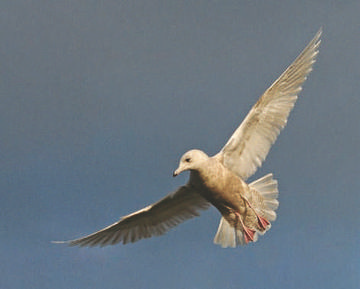Iceland Gull (Larus glaucoides)

Iceland Gull © Sheila Blamire
Iceland Gulls, confusingly, do not breed in Iceland but up to 100,000 pairs nest along the west and east coasts of Greenland. Most of those from west Greenland are resident or short-distance migrants and it is thought to be birds from east Greenland that move southeast to Iceland and the Faeroes, with some reaching Britain. Typically 100-200 a year winter in Britain, with occasional larger influxes, suggested to be linked to hard Arctic weather pushing more birds south or to poor years in the Icelandic fishing industry (Migration Atlas).
There were probably fewer Iceland Gulls in Cheshire during the three winters of our Atlas survey than at any time since the early 1980s. The winter distribution map exaggerates their status, as the records in five tetrads in SJ55 and SJ75 come from only two or three birds. They eat fish and waste food of all kinds, and almost all the records in the county in recent years come from refuse tips and nearby washing pools or roosts. In the 2004/ 05 winter, birds were seen at the Arpley landfill site (SJ58Y), an adult on 15 January 2005 and a first winter bird a week later. One or more birds were seen in three tetrads in the same area (SJ58M/ T/ X) in 2005/ 06, and an adult moved between Maw Green Tip (SJ75D) and the adjacent flashes (SJ75E and SJ75J) in late February 2006. In 2006/ 07 one bird was seen on Bar Mere, spanning SJ54I and SJ54J, a first-year bird visited Sandbach Flashes (SJ75J) on 20 December 2006, a second-winter bird was at Fiddler’s Ferry (SJ58M) on 21 December 2006, a first-winter bird was at Richmond Bank (SJ58T) on 30 December 2006 and a bird in third winter plumage was on Sutton Reservoir (SJ97A) a week before the end of this Atlas survey, on 20 February 2007.
Iceland Gulls used to be exceptionally rare, or under-recorded, in the county. A bird was shot at Hoylake, probably during winter 1872/ 73, and another was off New Brighton on 2 June 1909 (Coward 1910). The next records were in 1955 (Bell 1962) but since then birds have been annual and there have been records in every winter since 1956/ 57. Initially the status of annual winter visitor depended almost entirely on the return visits to New Brighton of the bird which was first seen in January 1957 when in its third winter and last seen there on 16 March 1985, not long after some birdwatchers had held a thirtieth birthday celebration in its honour. Birds were seen at Ness and Rostherne in the 1961/ 62 winter but it was only from 1967/ 68 onwards that annual winter visitor status ceased to be dependent on the New Brighton bird.
It is usually December before birds are seen and are then present in each month through to February in most winters, in variable numbers. Since the demise of the faithful old New Brighton bird there have been coastal records in only six winters and these are limited to one or two birds at one or two sites, usually on a single date. It is difficult to know how much of the rise in records was attributable to changed habits of birdwatchers, paying more attention to gull roosts and, later, to refuse tips and nearby pools where the birds washed and rested. From the 1970s Iceland Gulls were reported fairly regularly at the Rostherne roost, and from the 1980s, at or close to landfill sites such as along the River Mersey between Richmond Bank and Fiddler’s Ferry and the Witton and Sandbach Flashes. Cheshire and Wirral shared in national influxes in the 1980s and in the peak years there might have been as many as twelve individuals in the county, although numbers are hard to quantify because of movement between sites, variability in plumage as winter progresses and indeed difficulty in ageing many birds (White et al 2008).
From the late 1990s there has been a drop in records of both Iceland and Glaucous Gulls in the county, and in neighbouring Lancashire and North Merseyside (White et al 2008). If earlier influxes to Britain were driven by severe winter weather, it is tempting to think that the recent decline in wintering Arctic gulls in Cheshire and Wirral is linked to climate change.
Sponsored by Roy Eyres

